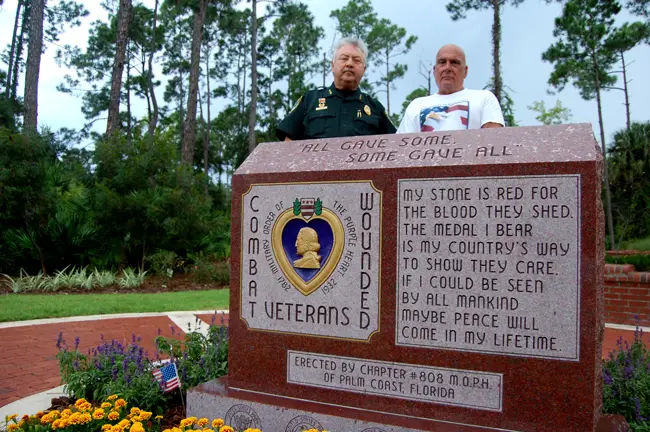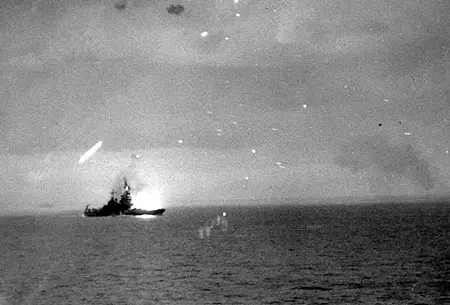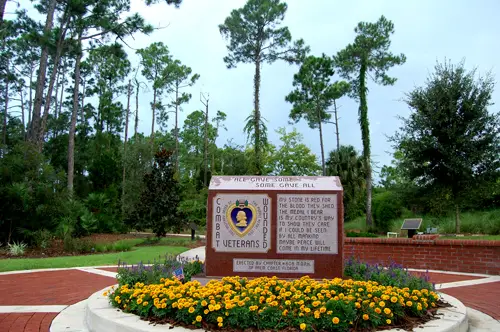
They were rehearsing their steps late Monday afternoon at Heroes Park in Palm Coast, Rick Look and Stephen Lunsford, who have five Purple Hearts and five tours of duty in Vietnam between them (three and three for Lunsford).
Early the following morning—Tuesday morning, at 8—they’d be among those dedicating Heroes Park’s newest shrine, a purple-granite monument, only the second of its kind in Florida, honoring all those who’ve received Purple Hearts and commemorating Palm Coast’s chapter of the Military Order of the Purple Heart—Chapter 808, formed on Sept. 22, 2008. (The ceremony, half a mile west of the public library on Palm Coast Parkway, to the right, is open to the public.)
Click On:
- Military Order of the Purple Heart
- National Purple Heart Hall of Honor
- Casualties in Iraq and Afghanistan
“The figure of a heart in purple cloth or silk edged with narrow lace or binding,” in George Washington’s description,” the Purple Heart was warded during Washington’s time, then revived in 1932, when the Military Order of the Purple Heart was formed to help needy veterans and their families. The Purple Heart isn’t awarded only to those wounded in combat. It also goes to the surviving next of kin of those killed in combat.
“Understand what a Purple Heart is,” Look, commander of the local chapter and the Flagler County Sheriff’s Chief Deputy, said. “Let’s say we go into the bush and we get under fire. We could be shot, multiple fragments of shrapnel or whatever. It’s multiple wounds, but it’s one event, so you get one Purple Heart.” Look was a grunt in Vietnam from 1967 to the end of 1968.
“For example,” Lunsford said, “in one instance—I’m not going to get into telling war stories, but I took a rifle round and shrapnel, it was only one event. And then the next day, we were trying to get our dead and wounded out, and they ambushed us again, and then I got a second Purple Heart the next day. They ambushed us with artillery. So those who weren’t wounded and dead, were wounded and dead. Everybody was gone.” Lunsford served in the Marines from 1965 through 1968.

After Look delivers the opening speech of the ceremony, with Palm Coast Mayor Jon Netts and Holsey Moorman, a city council member and retired general, at his side, three Palm Coast veterans will uncover the monument Tuesday morning: Lunsford, Felix Garcia, an Iraq veteran with three Purple Hearts, a traumatic brain injury cut his career short, and Larry Sinatra, a World War II and Korean War veteran. He was riddled with shrapnel from a Japanese Kamikaze pilot smashing into the 32,000-ton USS Maryland on Nov. 29, 1944, off Leyte. He was also on the USS Remey during the Korean War.
The stone was made in New Jersey. Donations through the military order’s local chapter, and particularly thanks to Jeffrey and Christine Puritis, covered the $7,000 cost. The city ensured that land was made available and landscaped for the monument, prominently, Heroes Park being a municipal park.
The local chapter is hoping that more veterans will join. “What we try to do is inspire them to come in, have a little fellowship, brotherhood,” Look says. “But this is our first achievement, and it’s been quite an achievement for the chapter. So we’re very proud of this.” The chapter has about 26 or 27 veteran members and eight more auxiliary members—next-of-kins who’ve been awarded the medal. “We have them from every conflict back to World War II,” Look says. And there’s been many. Most younger people would not know them by name: Korea, Vietnam and Cambodia, the Gulf War in 1991, Somalia, Iraq, Afghanistan. That’s without counting lesser-scale but still deadly military interventions along the way: Grenada, Lebanon (in 1958 and again in 1982-84), Bosnia, Haiti. There’ll be more.
And combat isn’t some of these veterans’ only battle experience. Combat, they could almost control. They could duck. They could fight. They could kill their enemy.
Jeffrey and Christine Puritis made their donation in honor of Cpl. Walter R. Gillis. The name appears on the back of the stone. Gillis wasn’t killed in action in Vietnam, where he served. He died since.
“Cancer got him,” Look says. “Cancer gets a lot of us from Vietnam because of that…” the commander’s voice trails off, as if remembering the words is itself lethal: Agent Orange. “They say if you could make it to 65 without cancer, maybe you’ll make it. I already had my cancer bout and I’m fighting that now.”
“And I’m going in for biopsies on the 5th,” Lunsford says. “The third set of biopsies.”
“And we’re young. Really, I turned 62 in November, he’s 64 tomorrow.”
“Today, today,” Lundsford corrects. It was the evening of Sept. 27. “A lot of us got saturated with it. As the planes came over and dropped it, we were literally saturated with it. Then when you bathed, the sheen would be on the water, because it’s like an oil base. And then when you walked through the grass, you’re rubbing up against it so it’s all in little spots and pigments dying.”
“So cancer is a real threat to Vietnam Veterans,” Look said. “Cancer is one of those things that we all fear as Vietnam Veterans, particularly those of us who were grunts in the field.”






























Charlie says
I salute all of those who served, and especially those awarded a purple heart.
Ann McKeown says
Greetings,
What a great thing to read about our vets, their wounds and their healing. Finally they are finding their voices, as well as the tremendous support of their buddies. Your stories are being heard and honored. So silent for so long.
You have carried the moral and spiritual burden and now society much take that on and allow our vets to heal. You have honored the rest of us and I salute who you are and your tremendous spirit. I work with veterans who have sustained traumatic brain injury and PTSD. A few of us understand that these are frequentlly lifelong changes you are asked to endure. May you continue to find your voices and never, ever let us forget what you have survived. My heart and best wishes go out to you. Ann McKeown
G says
My hat’s off as always to THE GREATEST GENERATION.